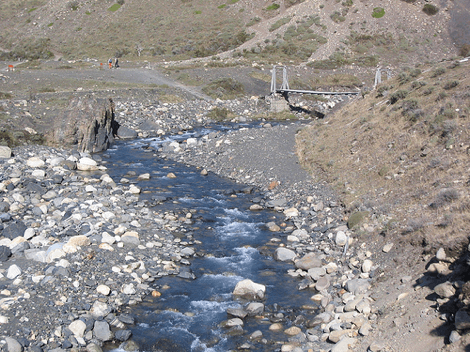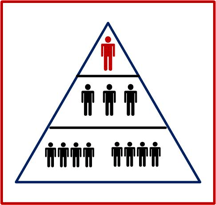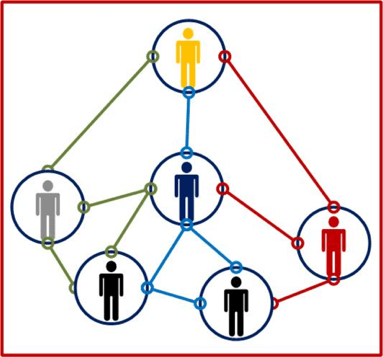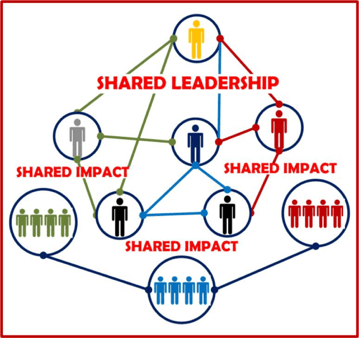When Aristotle said, “Nature abhors a vacuum” (Physics IV:6-9), he was referring to flow.
In the photograph below, look at the two channels in the stream. One is meandering, and the other is more direct. The meandering channel established a path that is different from the wider streambed. This even occurs when streambeds are dredged of silt to create a long, straight channel. Within a few months, the meandering curves return. Inevitably, flow finds its own path of least resistance.
A Case for A Flow-of-Leadership Business Model
In Design in Nature, Professor Adrian Bejan writes:
“Everything that moves, whether animate or inanimate is a flow system. All flow systems generate shape and structure in time in order to facilitate this movement across a landscape filled with resistance…”
This applies to the function of leadership in a surprising way.
The conventional view of leadership is that it is a role within an organizational structure. The people within that structure are divided between leaders and followers, like this:
Responsibility is set at the top and accountability is to the level above. It is built on order, control, and efficiency. This kind of structure worked for many millennia for many reasons. Principally, limited access to education and technology kept many people from advancing beyond the physical labor of the family farm or factory. These cultural situations acted as restrictions on the growth of this structure. Sources of friction, like these, are rapidly being removed; the result is that the place of leadership in organizations is changing.
By place, I mean function. The function of leadership in this older hierarchical model was management. The function of leadership in the future will be something quite different. Instead of managing order, it is creating an opportunity for leadership that looks more like this:
Leading in a Vacuum: The Older Model Versus the New Model
A vacuum is an open space. To envision this, think of two spaces: a bowl of water and a sponge.
The sponge is less dense; it has more open space than the water in the bowl. Place the sponge in the bowl, and the water flows into the sponge until it can hold no more. Take that same bowl of water, leave it out on your kitchen counter long enough, and the water in the bowl will evaporate into the air. The water in the bowl is denser than the air. However, for it to flow into the air, it must transform into water vapor.
This metaphor describes the changes and differences I see in leadership between the twentieth and twenty-first centuries. In the older model, the corporation absorbed the raw talent into its organizational structure. In the new model, the raw talent transforms the organizational structure. Today, there are fewer corporate jobs, so people are adapting to a world of independence, entrepreneurship, and networks of interdependency.
This is the difference is between a closed system of a few leaders and many followers and an open system where everyone can function as a leader. This is a natural change, but one that the leaders of outmoded organizational systems resist. Professor Adrian Bejan, mentioned above, makes the point that nature’s pattern is one of flow from one place to another following the path of least resistance. The natural flow of leadership then is to remove the barriers, restrictions, obstacles, and controls that bar people from developing as leaders. This prompts the following question:
Is leadership a function of management or is leadership a function of human beings?
To better address this question, let’s reverse it:
Are human beings born as functions of management or are we born to lead and make a difference with our lives?
This isn’t a question of nature versus nurture in human development. It is instead a question of how human beings function in modern organizational structures. It is a question of human purpose first and organizational purpose and structure second.
Remove the barriers that block human beings from fulfilling their potential, and leadership develops. Create openness, and leadership throughout the social and organizational setting will result. Leadership in the twentieth century was a product of organizational structure. Leadership in the twenty-first century is a product of human action. Simply put:
Leaders take personal initiative to create impact and make a difference that matters.
The flow of leadership, therefore, is the change that results from the human action rising from the individual initiative that fills the open spaces of opportunity to create the impact that is needed in each individual situation.
This means that any organizational structure that follows twentieth-century business models must change. Here’s how:
- The role of the executive changes from one who manages processes to one who facilitates the creation of opportunity and the development of the practice of leadership throughout the company.
- The organizational structure changes from a monolithic hierarchical one to a collection of smaller networked communities of leaders.
- Companies change from simply places of employment to places of human formation.
The transition is not an easy one, but it is a necessary one. It is not easy because the most fundamental structure of the modern world is required to change. What is that structure? The concentration of power and affluence into the hands of those who are designated as leaders—like this:
Make Room for the Flow of Leadership
What happens in an organization that creates a leadership vacuum? It opens up the opportunity for people to learn how to take initiative to create impact. We create a leadership vacuum when we don’t try to do what we cannot do. This isn’t a rationalization for the avoidance of responsibility. It is rather an intentional recognition that each person has gifts to offer to the functioning of the organization.
When leaders claim more responsibility, more authority, or more control than they are effectively able to manage, they are restricting the possibility for the leadership potential of others to be realized. Here’s how to make room for the flow:
- Do what you can do. Invite others to do what they can do. Be a team of shared initiative and contribution.
- Celebrate your values by creating a culture of unity and commitment to a shared purpose for your relationships and your work together.
- Create an organizational structure open to change and personal initiative to create impact.
An open structure of shared responsibility for each person to realize their own potential for making a difference that matters is the future of organizations. Executive leaders, as a result, push the responsibility for developing the processes and policies of the company down the organizational chart to the point of implementation. They also are constantly communicating the why of the company’s values alongside the how of the company’s policies and approach. They do this by being clear about how the values of the company are functioning throughout the organization.
Like a stream, openness for leadership helps the organization finds its path of least resistance to create impact. Like a vacuum, where there is openness to make a difference, people step forward to fill the space provided for them to make a difference. When each person does what they do best through their own personal initiative to create impact, the leadership capacity of the organization expands to become its greatest asset.
This is twenty-first-century leadership.
Photo by Andrew Worley on Unsplash






